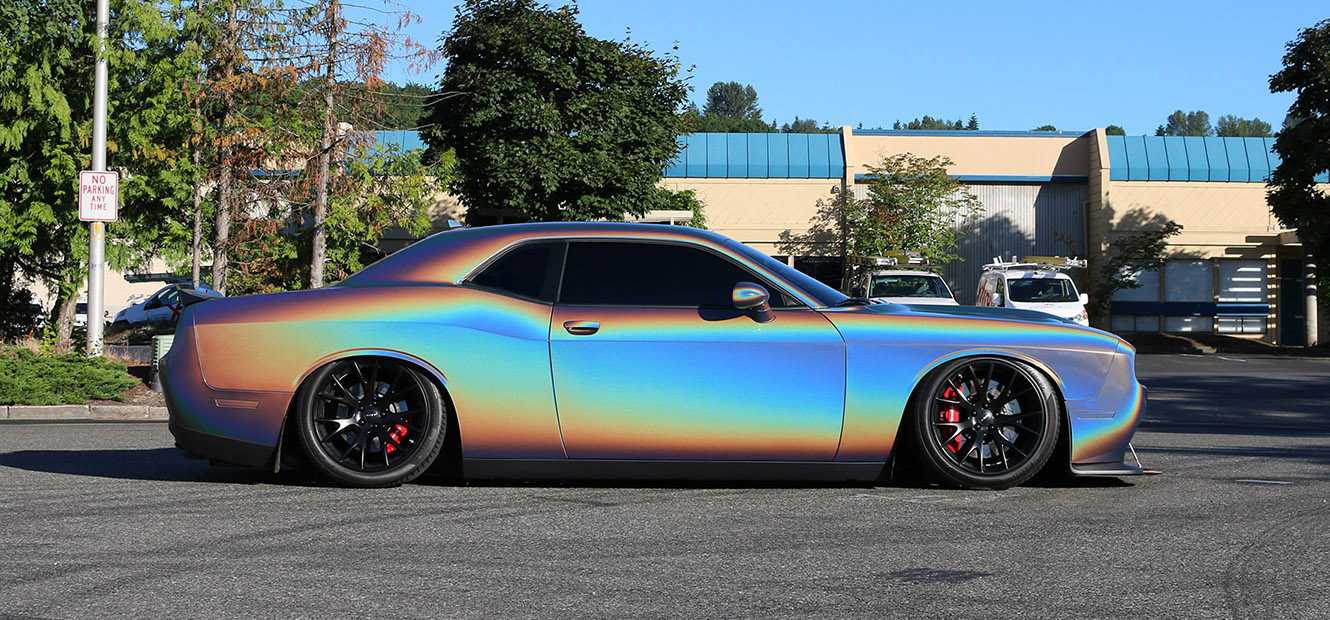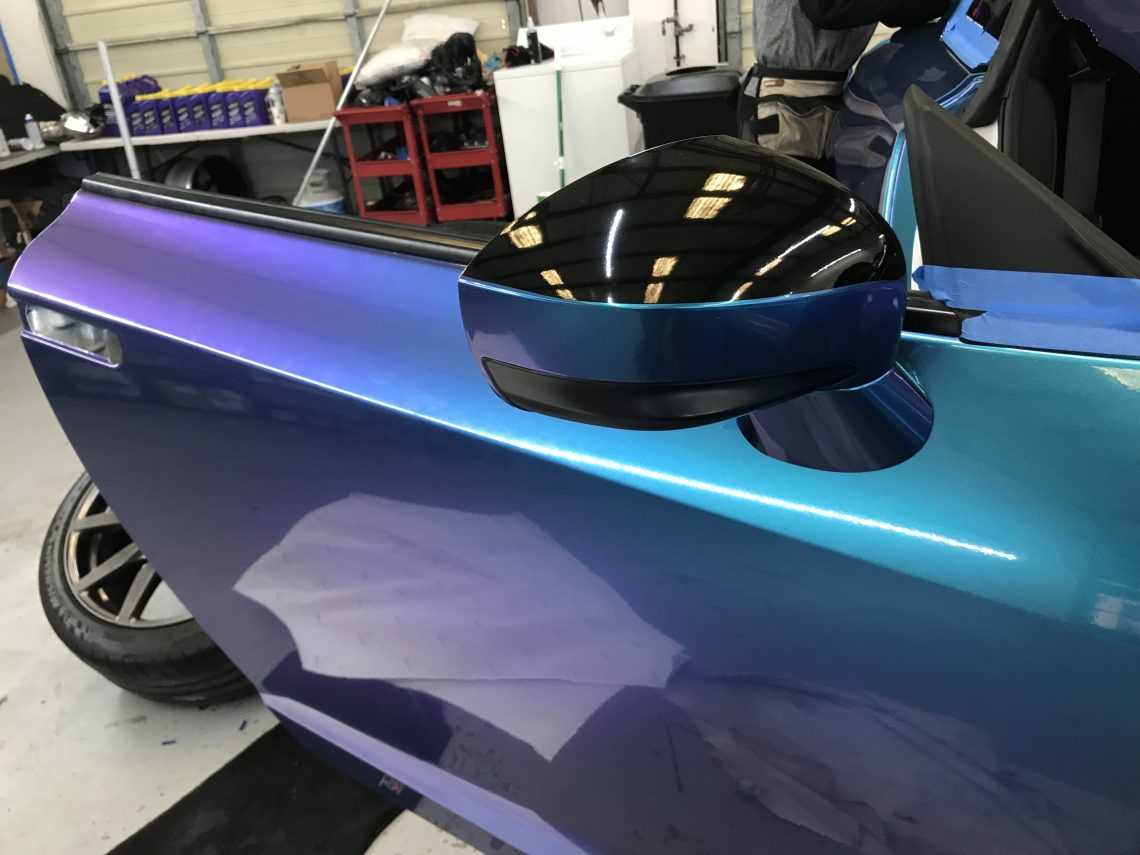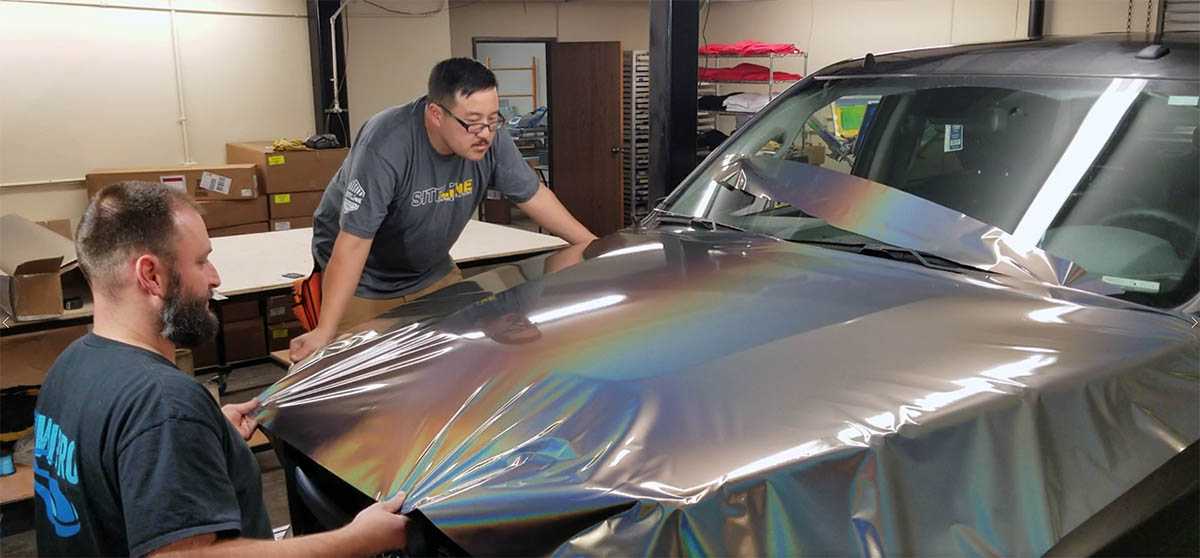Are you bored with your car’s original color? Or you just happened to buy a best selling model and your car looks like everybody else’s? In both cases, you have two options for a feasible facelift: either repaint your car anew or get a car wrap. You will want to find out how much does it cost to wrap a car versus the cost of a paint job, as well as the pros and cons of both options to choose wisely.
Car wraps are a fast-growing trend in vehicle customization, a reason for which is that wrapping allows you to change the look of your ride without a long-term commitment.
This article will deal with car wrap and cover everything you need to know to make your decision. Find out how much does it cost to wrap a car, plus answers for everything related to car wrap, including car wrap benefits, their lifespan, and the proper maintenance to make them last the longest.
Contents
What Is a Car Wrap?

A car wrap is a series of vinyl decals that are placed over the body panels of the vehicle, making your ride stand out from the rest. The design options include a standard glossy color, gradient color, matte finish, chrome metallic color, and full-on graphics treatments like those cars with colourful advertisements all over their bodies. The only limits are your imagination and of course, your budget.
Wraps were actually invented in the 1950s, but they were costly, so their use was limited to high-end vehicles. In recent years, with the rise of vehicle customization, wraps have become so popular that prices have dropped dramatically, making them a cheaper option than paint in many cases.
Why Wrap Your Car?
Finish and Designs
If you want a matte finish or a color-shifting paint or a highly customized paint job, painting your car would cost significantly more than wrapping it to achieve the same look. So in case you’re set on a specific finish and/or design that’s harder to achieve with a paint job, wrapping might be a better option, both economically and aesthetically.
Otherwise, assuming you have chosen a basic color for your paint job, a higher-quality paint job with multiple coats will cost about the same as a car wrap.
If you like tinted glass, you may even want to consider having the windows wrapped with perforated decals. From the inside, you’ll see a light, continuous tint, but from the outside, viewers will see any color or image you want to place there. It’s a whole new way of thinking about customization.

Removability
In addition, another advantage over regular paint jobs is the freedom from a long term commitment: the decals can be removed later with no impact on the existing paint, assuming the wrap was maintained correctly. You have the option of reverting to the original factory color, which is not possible with a paint job.
If you have a favorite color that isn’t offered as an option from the factory, a car wrap can be a solution. Many businesses make use of full-body wrap on company cars to serve as mobile advertisements. Interestingly, a car wrap is also the ideal option with leased vehicles: when you want a change of pace, just throw a wrap on it, drive it for a while then remove it before the lease is up.
READ MORE
Time and Labour
Whether you’re planning to take on a makeover project on your vehicle in your own garage or taking it to a shop, the time and labour it would take to paint or wrap your car is an important factor. In general, if you cannot be without your car for long periods of time, a wrap is the far less time-consuming option.
In case of a paint job, the old paint will need to be removed, which takes time. All paint jobs require multiple coats, and each coat of new paint will need to dry for 8 hours or so.
If the paint shop isn’t busy, you may have your car back in 3-5 days for a low-cost paint job, but 1 to 3 three weeks is more common for the average paint job.
Wraps take far less time to apply than paint. Once your design is finalized, it’s usually a 3-day maximum for installation. All we have to do is wash the car, dry it, and start applying vinyl.
How Long Does a Wrap Last?
If properly maintained, a car wrap can last up to five years. For very high quality wraps and utmost external care, you might get to enjoy your wrap for as much as ten years, though this is rare.

However, excessive sun exposure can “bake in” the vinyl wrap, making it harder to remove and significantly shortening its lifespan. As a result, if you always park the car outdoors and don’t keep it clean, the wrap might only last a year in some cases.
In addition to prolong sun exposure, other factors that affect the longevity of a car wrap includes weather and climate conditions, general exterior maintenance, frequency and type of car wash. Another note: if you live in consistently cold weather, remember that the salt used to melt snow on roads in cold states is hard on the vinyl.
In short, although a reason for wrapping your car is getting an extra protective layer for your original car paint underneath, you must understand how to take care of the wrap properly just like with the paint in order for your car to look its best for as long as possible.
READ MORE
How Much Does It Cost To Wrap A Car: Professional Services
The cost to wrap a car depends on many factors, including the size of your vehicle, whether you want a full or partial wrap, the quality of the wrap and the types of wrap, which determines the finish of the wrap.

For you to get a rough price range, a wrapping coverage of 40% of your vehicle will cost you from $600 for sedans to $900 for SUVs . If you need to cover up to 60% of your car, you will need at least $1,600 for a sedan, and at least $1900 for an SUV. A full wrap should cost between $2800 and $3400 for sedans and more for SUVs.
Types of Vehicle Wrap
As previously discussed, there are a wide variety of vehicle wraps with unique pros and cons in terms of aesthetic presence and price range. Below are the four most popular car wrapping types and their prices.
Do note that while some service shops will charge by the square feet plus labour cost, many will quote a set price for the entirety of the vehicle wrapping project.
Vinyl Matte
For a vinyl matte vehicle wrap, the average price is between $2.00 and $3.50 per square foot. If your vehicle is a midsize four door sedan, that matte vehicle wrap could cost you around $2,000 and could be even more expensive depending on the size of the vehicle.
Vinyl Satin or Gloss
Vinyl satin or vinyl gloss is another cost-effective option, ranging between $1.50 to $3.50 per square foot. As opposed to the understated and modern matte finish, a satin finish is silky with just enough shine while a gloss will give your ride a full bling.
Carbon Fiber
One thing must be made clear: Carbon fiber vehicle wrap is just imitation carbon fiber. The real carbon fiber is an innovative solution for structural strengthening, despite being lightweight, and thus is a very expensive material. Carbon fiber offers a strong resistance to harsh weather conditions.
Carbon fiber wrap used on vehicles, or “carbon fiber vinyl”, is usually sold in rolls or sheets, and is usually a PVC-based vinyl that has an adhesive backing and can be stuck onto surfaces like a big sticker. It tries to mimic the real carbon fiber look. Per square foot, carbon fiber wrap usually ranges between $3 to $7.
Aside from looks, carbon fiber wrap will add weight, so there are no real structural or strength benefits, although it would offer some level of scratch protection. This is generally for people who want the look of a carbon fiber vinyl wrap and do not want to pay the premium price for real carbon fiber.
Chrome

Chrome vehicle wrapping per square foot is a little more expensive than the vinyl matte starting at $8 per square foot and upwards depending on the quality of chrome you desire for your vehicle wrap.
Chrome or metallic finishes are significantly more expensive due to the higher cost of the materials and the added complexity of installation. Chrome wraps can turn dull when they’re overheated or when they are stretched over a curved surface.
Expect to pay roughly $6,500 to $8,000 for a chrome wrap, and even more if your vehicle is a big baby. Custom, metallic paint jobs on high-end sports cars have been known to run upwards of $60,000.
Can You Wrap Any Car?
Your paint has to be in good condition if you plan on wrapping a vehicle. Any dents, scratch or imperfections in the finish will not be hidden by the wrap, and they’ll inhibit proper vinyl adhesion. If your vehicle is old and the paint job is now a mess, it’s better to go with a paint job instead of a wrap.
DIY Car Wrap
Now that you have had an idea of how much does it cost to wrap a car, you might want to know the basic process of car wrapping in case you’re pondering over whether to tackle it on your own. It is generally not a very easy project, so if you’re a novice or if you’re opting for a tricky design and finish, it’s best to leave it to the professionals.
Car Wrap Prepping
Pre-Installation cleaning products & tools:
- Wrap Gloves
- General Paint-safe Cleaner
- Grease and wax remover
- Isopropyl Alcohol
- Lint-Free Towel or Lint-Free Paper Towel
- Squeegee
- Sharp Blade
- Heat Gun
- Utility knife
- 3M 94 Tape Primer
- Masking tape
- Tape measure
Car Wrap Process

Surfaces with any grease, oil or wax greatly reduce film adhesion and may form bubbles on neglected areas. First, wash the vehicle using a grease and wax cleaner and detail it with a clay bar to remove any contaminants from the surface of the paint.
Some installers use a solution of isopropyl alcohol to clean the paint then blow off any remaining dirt particles with compressed air. It should be noted that alcohol is best used for spot cleaning and a quick wipe-down. Alcohol-based cleaners, such as isopropyl alcohol may be used, but are not as effective at removing wax in comparison to solvent-based cleaners.
Make sure the surface is completely dry before applying the film. Then, remove the bumpers, headlights and taillights so that the installer can apply the wrap as close to the edges of the body panels as possible. If you’re not comfortable with the shop taking the car apart, you can instead use a scalpel-like tool to cut the vinyl around the lights and grilles.
Then apply the vinyl wrap to the body of the vehicle. Use a heat gun to make the material more pliable, so it can properly hug the contours of the vehicle. Some of the more advanced wrap designs, such as those using graphics or custom colors, will require additional vinyl layers. Finally, use a soft felt squeegee to remove any air pockets.
The whole process can take a few days to complete. It’s longer if you want the door jambs – the inner body-colored part of your doors – to match. The door jambs alone will take a day and a half.
The doors need to be taken apart before being wrapped, which adds more labor and cost to the installation. Black cars make the ideal candidates for wrapping, as the door jambs are less noticeable and you don’t have to spend extra for them to be wrapped.
How Much Does It Cost to Remove a Car Wrap?
When the time comes to sell your car or return your leased car, or if you just want to go back to the original paint, take the car back to the shop that applied the wrap. If the wrap was applied properly and has retained its structural integrity, removal should be straightforward.
The process can take three to four hours and costs $500 to $600. A difficult removal, such as where the wrap was baked in and begins to come apart as the shop removes it, would cost about $2,500 for the added labor.
The removal process starts with cleaning off any sticky wrap residue with an adhesive remover. Then, the car gets another clay bar detail to remove any impurities from the clear coat.
If everything goes well, the wrap will not have damaged the paint, which is the ideal scenario. If your paint was not in the best shape or was repaired at some point with a thinner coat, there’s a chance that some of it might come off with the wrap.
Car Wrap Maintenance Tips
Can a wrapped car go through a carwash?
Wrapped vehicles can be run through a car wash, with a touchless system being the best choice. Use of brush car washes may cause damage to your vehicle graphic, including dulling, scratching, and lifting the edges of the film. It is also possible to pressure wash a vehicle with a graphic wrap.
Should I wax a wrapped car?
Adding a protective wax finish to paint may protect it from exposure, but it doesn’t always help vinyl car wrap. In fact, wax buildup may even damage the wrap. In addition, in most cases there’s little need to wax vinyl graphics, because they look great without polish.
If your vehicle is a partial wrap or has decals, you’ll want to wax the exposed painted surfaces, but be careful to keep the wax away from the graphics and remove any build up from the edges. If wax does build up on the vinyl carefully remove it using soap and water with a nonabrasive cloth such as microfiber.
Some professionals may recommend that you use a waterless wash and afterwards wax your wrapped vehicles. To be safe, note that you should only do so if the wrap finish is not matte and the wax does not contain petroleum distillates, which is found in many paste waxes.
READ MORE
Does wrapping a car ruin the paint?
Rest assured, a vehicle wrap will not damage factory paint or high quality paint. In fact, not only will a wrap not damage the painted surface of your vehicle, if the paint is factory paint the wrap will protect that surface and preserve the quality of the paint underneath.
Do car wraps scratch easy?
Because vinyl wraps are nothing more than just a film on the surface of the car, they’re pretty susceptible to getting little nicks and scratches even if it doesn’t break the vinyl.
Does the colour of a car wrap fade?
No. High quality wraps will keep their color for the entire life of the wrap. High temperatures and UV rays are not a concern with a high quality wrap.
Does wrapping a car prevent rust?
Rust will continue to spread and eat away at your car if it is not gotten rid of, whether you wrap it in vinyl or not. … Once your car is wrapped in vinyl and you have no rust under it, it will keep it safe from surface rust and stone chips, scratches that could cause rusting from the outside.
Can you wrap a car with scratches and dents?
Technically, vinyl vehicle wraps can be applied over scratches or a similar degree of small damage. However, don’t expect the wrap to serve as a cover-up for an old or bad paint job. Although you won’t see it when the car is wrapped, the paint has to be in good condition or the wrap will be a mess.
If the vehicle has scratches and door dings, they’ll stick out like a sore thumb. Imperfections under the wrap will always show up on the surface. If the old paint has started to flake, the decals will have a hard time adhering to it. It is best to get any scratches or dents fixed before wrapping the vehicle.


